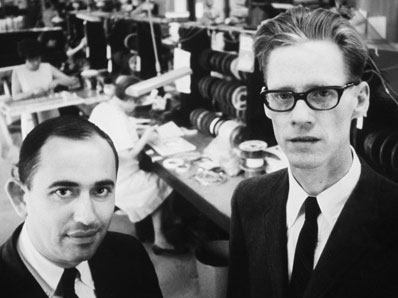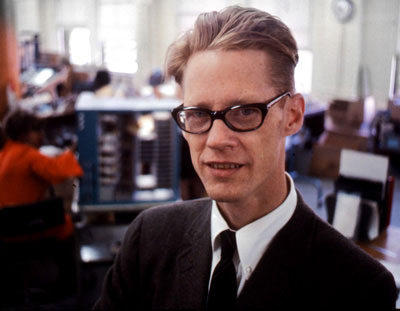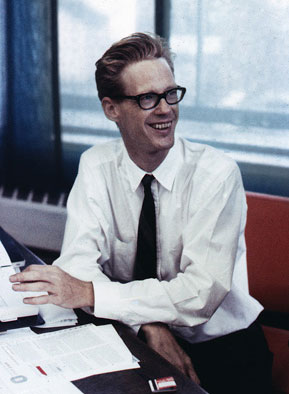|
One of our industry legends, Nick DeWolf, has passed on. DeWolf co-founded Teradyne with Alex d'Arbeloff, who together built our industry's ATE business.
Born in Philadelphia on July 12, 1928, he went on to graduate from the Massachusetts Institute of Technology at the tender age of 19. He started in the industry as an engineer for General Electric in 1948 when the world was trying to master the solid state diode. The challenge was not so much in the making of them, but in the testing of them. DeWolf mastered the technology and quickly became an expert. Because GE could test them better than anyone, they became a leader and the company also marketed a tester designed by DeWolf. In 1952, he wrote the following cannons of design: -The Design of Factory Production Test Equipment
1) It
must be reliable. There is much to learn from these, as most still apply more than a century later. Amazingly, he was only 24 when he wrote them and it was at a time when solid state electronics were in their infancy. Most people live a lifetime without such brilliance and clarity of thought. Another gem of DeWolf's was his belief that what customers want is seldom what they need and you should design to the latter. In those days, few knew this basic principle of product marketing (I learned it from Bob Graham much later and did not see it pop up in business treatises until half a century after our industry's marketing greats had fully mined it out). Nick DeWolf was tall and reed thin. The sparkle in his eyes, gives away a hint of uncommon intelligence.
Soon after he wrote the canons of design, he resigned to become chief engineer at Transitron in the same year. The company was a darling of the mid-1950s, with its gold-bonded diodes and later transistors. It quickly rose to number two, just behind Texas Instruments, with DeWolf's genius being hailed outside the technical world. In the August 1959 Fortune article, The Company That Started With a Gold Whisker, he was noted as Transitron's best salesman. He and others would soon leave and Transitron would disappear for a simple reason: its founders failed to share in the wealth. Nick would not make that mistake when he started his own company, which he would soon do. In 1960, he got together with former MIT classmate Alex d'Arbeloff, to start-up Teradyne above Joe and Nemo's hot dog stand in downtown Boston. Nick the technical genius was perfectly complemented by Alex, who had an untapped genius for business. Together, they would become the Hewlett-Packard's of Boston. They were only 32 and each, using $25K of their own money, were able to attract an additional $175K from friends and family. They picked the name because it sounded high tech with tera standing for 10 to the twelfth power and dyne standing for force, when taken together signify about a thousand tons of force. The business plan was a short four pages. What was unique was its comprehension of the need to meld technology with productivity and economics. Here is a key insight in their thinking that would build such a success story: The penalties to the user of undetected improperly functioning equipment may be many times the original cost of the equipment. With this too-simple statement, they encompassed what would be the entire business model for all ATE.
They
opened their doors in November and were invited to bid on a
Semi-Automatic Diode Test Set by Raytheon in January of 1961. As
the year would close, they would have revenues of $47K. It was
here that the company's so-called teragance (arrogance to the power
of twelve) took form, as DeWolf was not about to design a custom
tester. They has asked for a throughput of 1200 diodes per hour, he
offered 3600 and promised to run all five electrical tests without a
productivity loss, when they had asked that the system stop when any
test failed. They asked for a one-year warranty and he gave them
ten. If you think outsourcing and partnering is new, think again, as
he worked with meter manufacturers to develop improvements that
would give Teradyne an advantage in speed and testing leakage
currents. He partnered with
Nick Cedrone,
who had founded
Daymarc,
to develop a fixture that would make good contact when the operator
put the diode in the tester. If the operator put the diode in the
wrong way, the tester automatically reversed polarity. Finally, he
abandoned classic black crackle or grey paint for an aluminum panel
covered with mylar and Letra-set lettering, which allowed them to
quickly change model numbers and instrument labels on the front.
Modular design would allow them to quickly reconfigure the system to
different customer requirements. The build-to-order model of
Michael Dell was actually pioneered by DeWolf, with the exception
that each application would get a different model number leading to
the impression that Teradyne was much bigger than life. Indeed, as
CEO, DeWolf would design more than more than 300 testers. Included
in this would be the legendary J259, the world's first
computer-operated semiconductor test system. To see what the J259
looked like, click on Teradyne went into the black in 4Q1962, exactly two years after their founding. In 1963, revenues had grown to $431K with profits of $46K the latter almost matching revenues from 1961. It was a time when men were dreaming of going to the moon, and Teradyne was already there. That year, they offered quotes on 57 different testers because of the scalable architecture DeWolf had put in the first tester. It shows how far he was ahead of his time. In that same year, they were visited by Ikuo Takeda, the founder of Advantest, showing what a small world hi-tech was even then. Hearing of Teradyne's new approach to testing, he was drawn across the world. He got the cook's tour, and as was customary in those days, was allowed to photograph what he saw. But in those days the real competition was on the other coast Fairchild Test Systems Group. By 1964, testing was becoming too complex for simple relay testers. The IC had been in production for over a year. DeWolf and d'Arbeloff had been introduced to DEC's Ken Olson by a mutual investor. They would soon quote the T231 Transistor Tester with an electrical connection to DEC's PDP 8. Sales hit $1.9M that year and profits $236K. Teradyne bought two PDP 8's for $18K each. Introduced in 1966, the J259 came with a DEC PDP-8 miniature computer, paper-tape reader, and teletype as I/O. It went for the astounding price of $58,500 (a new Volkswagen Beetle cost $2K and very hi-end luxury cars were $6K. It was also a completely new platform and one of the first designed around ICs. This was at a time when few mainframes used ICs. Super successful, it drove Teradyne's sales to $3.8M in 1966, then $5.7M in 1967, and $9.1M in 1968. But the PDP-8's short 12-bit world length was already constraining their systems. That led to the development of the M365, which Nick argued was one of the world's first RISC computers. It became the engine of Teradyne's early IC testers. After this came the J283 SLOT machine (standing for Seqential Logic Test) targeted at the emerging linear market. There were many others who made significant contributions to the development of these systems. But Nick was still heavily involved even though he still held the title of CEO. In 1969 sales hit $15.4M and profits $1.2M and the company went public. But the pressures of a public company were too much for DeWolf, who would step down in 1971. He went on to travel the world and express his creativity with photography. Some of his excellent photos from these travels still adorn Teradyne's campuses. But he always wanted to be known as an engineer first, even though he had a passion for photography, acting, inventing, and the free exchange of ideas. In 1979, he received of the SEMI Award for outstanding contributions to the semiconductor test industry. To learn more about this history, get a copy of Teradyne: The First Forty Years, by Frederick Van Veen (from which I liberally borrowed to write this short piece). Fred is another legend from Teradyne and we are all greatly indebted to him for taking the time to write up the history of this great company. Meanwhile, here is one last photo of Nick doing what he loved best, engineering:
DeWolf eventually settled with his family in Aspen, where he would die in April 2006 at the age of 77. There, he was involved in many civic, charitable, and educational programs. DeWolf had paved the way for today's electronics industry with his pioneering development of test technology for semiconductors. He was a giant of an engineer and he had a passion for America's leadership in technology. In a recent interview he said, "I wish more Americans would become engineers; fewer lawyers and doctors, and I really wish for one thing with great passion and that is that physics should be taught before biology and chemistry...So if I had any one thing I'd love to see happen, it is that America would get more technical again." DeWolf and his accomplishments should serve as a lighthouse for all of those who wish to sail the dark waters of the future. |


